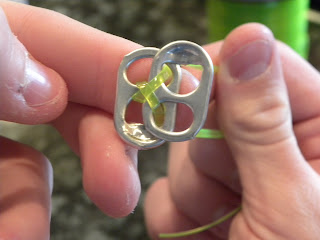Messenger Bag
Materials - 100 yards of green and black durable/plastic ‘wire’, at least 1000 pop tabs (maybe more depending on size).
This project is a fun one. I figured I could use a messenger bag since I am one of the only people in my class that can’t drive yet and so I need a bike-friendly pack. If you’re like me, or you just want to bike with your things, this project should be a good one for you.
Step 1 - Start out by cleaning you tabs. To do this, I used a colander to hold the tabs while I sprayed water over them. This step gets all of the stickiness off the tabs and washes the dirt and grime off so they look shinier.
Step 2 - Next, get your wire out. I’m using green wire as my main wire because every day for two years, I have worn green and it is now one of my favorite colors. I cut my line a little over a yard long, just to be safe.
Step 3 - Start out by looping your wire around your first pop tab and pull half of the line through both sides. The easiest way to do this is by folding the line in half and pulling the line through and using your hand, following the tab down until it reaches the end.
Step 4 - Next, take another pop tab and position it upside down from the first one. Place the ends of your line and thread them through so they cross over and into the second tab. After you put them through the second tab, drop the line down through the first pop tab.
Step 5 -Place another tab next to the top one and bring the two lines straight across from where they came down it thread them up through the other side of the bottom tab and the farthest left side of the second top tab.
Step 6 - Cross over the second tab and thread it down through a new second tab on the bottom. Repeat 3-6 until you get to the desired length.
***NOTE***
When you make your long side (the side you will use as the main side) make sure the top taps are in an equal number. This will make your life so much easier. I didn’t realize that I had made strips with odd numbers until it was too late to go back and undo them all.
Step 7 - After you get all of your strips, you can stitch them together by going from the bottom of the top row, to the top of the bottom row.
Step 8 - To finish the project, you have to continue creating lines until you reach a desired length and width for every side. The way you 'sew' these together is by starting at the top left of one corner and working from the left to the right and crossing down to get to the new left. Attach the three sides to one main side and then attach the last back part. Because I wasn't able to finish the project in time for the Personal Project deadline, I promise any readers interested in this project that I will complete this at a later date and post pictures of both the process and outcome.
Time Working on Project
December
17 - gathered resources, about an hour and a half to find everything
18 - started project, spent about 3 and a half hours working on the front plate
19 - hardly worked on it. Spent maybe 15 minutes on it
20 - started getting the hang of it, put about 3 hours towards the front plate.
21 - Another 2 hours of work, finally got 11 rows down the front plate.
22- decided to work for 30 minutes on the bottom, went with six on top
23 - 2 hours of work, tied together the plate
24 - decided that it wasn’t wide enough, took it apart, started working on a plate with 7 on top (total of 15 per chain) spent about 2 and a half hours working on it



































